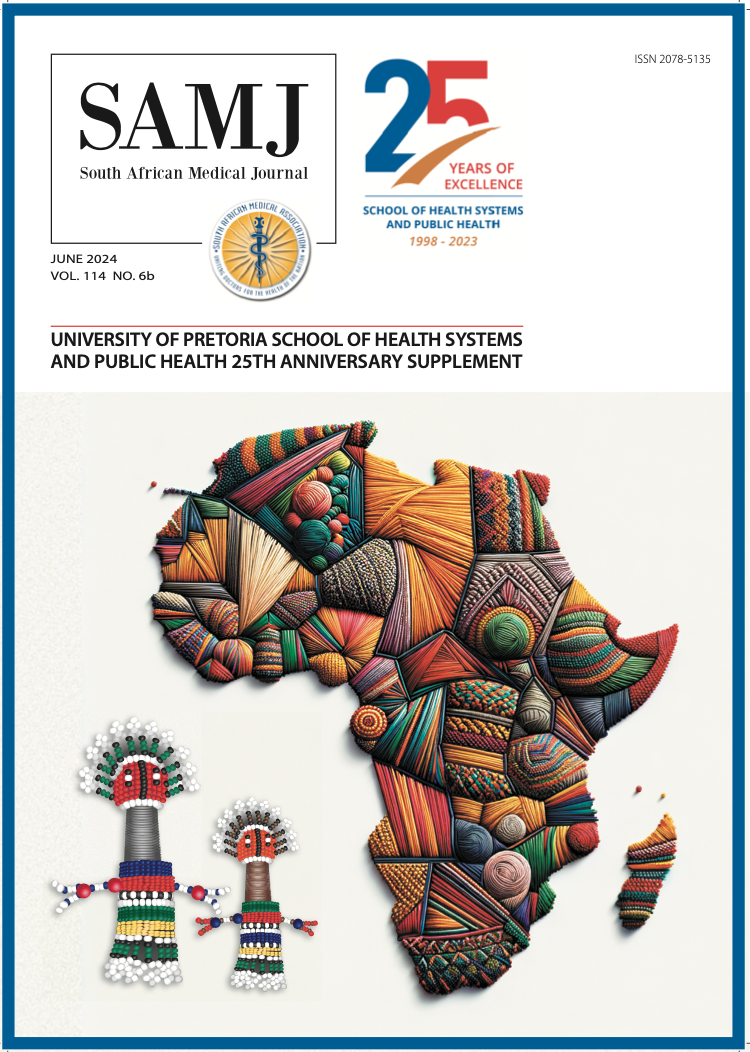Trends and factors associated with adverse pregnancy outcomes in Zimbabwe, 2005 - 2015
DOI:
https://doi.org/10.7196/SAMJ.2024.v114i16b.1399Keywords:
trends, factors, adverse pregnancy outcomes, abortions, miscarriages, stillbirths, ZimbabweAbstract
Background. Adverse pregnancy outcomes, including abortions, miscarriages and stillbirths, are common in developing countries such as Zimbabwe.
Objective. To determine the trends and factors associated with adverse pregnancy outcomes.
Methods. This article is a secondary data analysis of three repeated cross-sectional Zimbabwe Demographic and Health Surveys to assess adverse pregnancy outcomes among women of reproductive age (15 - 49 years old) who fell pregnant during the study period. Bivariate and multivariable logistic regression models were applied to the 2015 dataset to determine factors associated with adverse pregnancy outcomes.
Results. There was an overall increase in reported adverse pregnancy outcomes (stillbirths, miscarriages and abortions) from 2005 to 2015. The percentage of women who experienced adverse pregnancy outcomes among those who fell pregnant in the 5 years preceding each survey rose from 13.4% in 2005 to 13.8% in 2010, followed by a sharp increase to 16.3% in 2015. The multivariable model, belonging to the 35 - 49-year age group, was associated with almost a twofold increased odds of experiencing an adverse pregnancy outcome (adjusted odds ratio (aOR) 2.11, 95% confidence interval (CI) 1.35 - 3.31, p=0.001). Women currently married/in a union (aOR 4.69, 95% CI 2.64 - 8.34, p<0.001) or formerly married/in a union (aOR 3.56, 95% CI 1.89 - 6.69, p=0.001) had higher odds of experiencing an adverse pregnancy outcome. Not belonging to any religion or being a traditionalist or Muslim decreased the odds of experiencing an adverse pregnancy outcome (aOR 0.58, 95% CI 0.42 - 0.80, p=0.001). Women from Harare (aOR 1.56, 95% CI 1.05 - 2.32, p=0.027), Mashonaland West (aOR 1.59, 95% CI 1.08 - 2.36, p=0.027) and Mashonaland Central (aOR 1.76, 95% CI 1.15 - 2.69, p=0.009) provinces had higher odds of experiencing adverse pregnancy outcomes than those from Bulawayo Province. Women who gave birth for the first time at ≥25 years of age (aOR 3.08, 95% CI 2.27 - 4.16, p<0.001) had higher odds of experiencing adverse pregnancy outcomes. Women who delivered 2 - 4 children (aOR 0.75, 95% CI 0.59 - 0.95, p=0.018) or ≥5 children (aOR 0.51, 95% CI 0.36 - 0.72, p<0.001) were less likely to experience adverse pregnancy outcomes.
Conclusion. Trends showed an increase in the proportion of women experiencing adverse pregnancy outcomes in Zimbabwe from 2005 to 2015. Advanced maternal age, marriage, lack of religion and living in Harare, Mashonaland Central or Mashonaland West were associated with adverse pregnancy outcomes. There is a need to reduce these outcomes through integration of social issues into maternal health programmes, as well as ensuring accessibility and availability of comprehensive reproductive health services that target high-risk groups such as women aged 35 - 49 years.
References
Yeshialem E, Abera M, Tesfay A. Determinants of adverse pregnancy outcomes among mothers who
gave birth from Jan 1 - Dec 31/2015 in Jimma University Specialised Hospital: A case control study.
Ethiopian J Reprod Health 2019;11(1):10-10. https://doi.org/10.21767/2471-299X.1000063
Sedgh G, Singh S, Hussain R. Intended and unintended pregnancies worldwide in 2012 and recent
trends. Stud Fam Plan 2014;45(3):301-314. https://doi.org/10.1111/j.1728-4465.2014.00393.x
Mungoba TN, Mitonga K, David SA, Musekiwa A, Nakale T. Factors associated with adverse
pregnancy outcomes among women who delivered at Intermediate Hospital Oshakati, Namibia. Int J
Med 2016;5:6939. https://doi.org/10.14419/ijm.v5i1.6939
Chaibva BV, Olorunju S, Nyadundu S, Beke A. Adverse pregnancy outcomes, stillbirths and early neonatal deaths in Mutare district, Zimbabwe (2014): A descriptive study. BMC Pregnancy Childbirth 2019;19(1):1-7. https://doi.org/10.1186/s12884-019-2229-3
Tamirat KS, Sisay MM, Tesema GA, Tessema ZT. Determinants of adverse birth outcome in sub- Saharan Africa: Analysis of recent demographic and health surveys. BMC Public Health 2021;21(1):1- 10. https://doi.org/10.1186/s12889-021-11113-z
Asiki G, Baisley K, Newton R, et al. Adverse pregnancy outcomes in rural Uganda (1996 - 2013): Trends and associated factors from serial cross-sectional surveys. BMC Pregnancy Childbirth 2015;15(1):1-12. https://doi.org/10.1186/s12884-015-0708-8
Moss W, Darmstadt GL, Marsh DR, Black RE, Santosham M. Research priorities for the reduction of perinatal and neonatal morbidity and mortality in developing country communities. J Perinatol 2002;22(6):484-495. https://doi.org/10.1038/sj.jp.7210743
World Health Organization. Trends in maternal mortality 2000 to 2017: Estimates by WHO, UNICEF, UNFPA, World Bank Group and the United Nations Population Division. 2019. https://apps.who.int/ iris/handle/10665/327596 (accessed 23 May 2023).
Grove J, Claeson M, Bryce J, et al. Maternal, newborn, and child health and the Sustainable Development Goals ‒ a call for sustained and improved measurement. Lancet 2015;386(10003):1511- 1514. https://doi.org/10.1016/S0140-6736(15)00517-6
World Health Organization. Maternal health: Fact sheet on Sustainable Development Goals (SDGs): Health targets. Geneva: WHO, 2017.
Hug L, Mishra A, Lee S, et al. A neglected tragedy: The global burden of stillbirths. Report of the UN inter-agency group for child mortality estimation. Geneva: United Nations Children’s Fund, 2020. https:// data.unicef.org/resources/a-neglected-tragedy-stillbirth-estimates-report (accessed on 23 May 2023).
De Bernis L, Kinney MV, Stones W, et al. Stillbirths: Ending preventable deaths by 2030. Lancet 2016;387(10019):703-716. https://doi.org/10.1016/S0140-6736(15)00954-X
World Health Organization. Every newborn: An action plan to end preventable deaths. 2014. https:// www.who.int/publications/i/item/9789241507448 (accessed 23 May 2023).
Koblinsky MA. Reducing maternal mortality: Learning from Bolivia, China, Egypt, Honduras, Indonesia, Jamaica, and Zimbabwe. World Bank Group eLibrary, 2003. https://doi.org/10.1596/0- 8213-5392-6
Witter S, Chirwa Y, Chandiwana P, et al. Results-based financing as a strategic purchasing intervention: Some progress but much further to go in Zimbabwe? BMC Health Serv Res 2020;20(1):1-18. https:// doi.org/10.1186/s12913-020-5037-6
Shava E, Mutangabende S. Assessing progress and pitfalls of the Millennium Development Goals in Zimbabwe: A critical analysis. Africa’s Public Service Delivery Perform Rev 2016;4(4):573-605. https:// doi.org/10.4102/apsdpr.v4i4.141
Ministry of Health and Child Welfare (MoHaCW). The Zimbabwe National Maternal and Neonatal Health Road Map 2007 - 2015. Harare: MoHaCW, 2007. https://extranet.who.int/countryplanningcycles/ sites/default/files/planning_cycle_repository/zimbabwe/zimbabwe_mnh_roadmap_2007-2015_0.pdf (accessed 16 June 2023).
United nations Children’s Fund. Maternal and Newborn Health Disparities: Country Profiles. 2022.
https://data.unicef.org/resources/maternal-newborn-health-disparities-country-profiles (accessed on
June 2023).
Amjad S, MacDonald I, Chambers T, et al. Social determinants of health and adverse maternal and birth outcomes in adolescent pregnancies: A systematic review and meta-analysis. Paed Perinatal Epidem 2019;33(1):88-99. https://doi.org/10.1111/ppe.12529
Kramer MS. The epidemiology of adverse pregnancy outcomes: An overview. J Nutr 2003;133(5):1592S-1596S. https://doi.org/10.1093/jn/133.5.1592s
Mosley WH, Chen LC. An analytical framework for the study of child survival in developing countries. Popul Develop Rev 1984;10:25-45. https://doi.org/10.2307/2807954
Baruwa O. Understanding the trends and variations of abortion in regions of Ghana from 1998 - 2014.
https://uaps2019.popconf.org/uploads/190048 (accessed 23 May 2023).
Cousens S, Blencowe H, Stanton C, et al. National, regional, and worldwide estimates of stillbirth rates
in 2009 with trends since 1995: A systematic analysis. Lancet 2011;377(9774):1319-1330. https://doi.
org/10.1016/s0140-6736(10)62310-0
Murewanhema G, Makurumidze R. Essential health services delivery in Zimbabwe during the COVID-19 pandemic: Perspectives and recommendations. Pan Afr Med J 2020;35(Suppl 2). https:// doi.org/10.11604%2Fpamj.supp.2020.35.143.25367
Lean SC, Derricott H, Jones RL, Heazell AE. Advanced maternal age and adverse pregnancy outcomes: A systematic review and meta-analysis. PLoS ONE 2017;12(10):e0186287. https://doi.org/10.1371/ journal.pone.0186287
Frick AP. Advanced maternal age and adverse pregnancy outcomes. Best Practice Res Clin Obstet Gynaecol 2021;70:92-100. https://doi.org/10.1016/j.bpobgyn.2020.07.005
Mukamana JI, Machakanja P, Adjei NK. Trends in prevalence and correlates of intimate partner violence against women in Zimbabwe, 2005 - 2015. BMC Internat Health Human Rights 2020;20(1):1- 11. https://doi.org/10.1186/s12914-019-0220-8
YostNP,BloomSL,McIntireDD,LevenoKJ.Aprospectiveobservationalstudyofdomesticviolenceduring pregnancy. Obstet Gynecol 2005;106(1):61-65. https://doi.org/10.1097/01.aog.0000164468.06070.2a
Mezey GC, Bewley S. Domestic violence and pregnancy: Risk is greatest after delivery. BMJ
;314(7090):1295. https://doi.org/10.1136/bmj.314.7090.1295
Bohn DK. Domestic violence and pregnancy: Implications for practice. J Nurse Midwifery
;35(2):86-98. https://doi.org/10.1016/0091-2182(90)90064-c
Hardoff D, Tamir A, Weizman T, Peretz AB. The adolescent parturient: A study of an Israeli population.
J Adolescent Health 1996;19(5):362-365. https://doi.org/10.1016/s1054-139x(96)00057-2
UjahI,AisienO,MutihirJ,VanderjagtD,GlewR,UguruV.Maternalmortalityamongadolescentwomenin Jos, North-Central, Nigeria. J Obstet Gynaecol 2005;25(1):3-6. https://doi.org/10.1080/01443610400023395 33. Hamal M, Dieleman M, de Brouwere V, de Cock Buning T. Social determinants of maternal health: A scoping review of factors influencing maternal mortality and maternal health service use in India.
Public Health Rev 2020;41(1):13. https://doi.org/10.1186/s40985-020-00125-6
NyathiSS,NdhlovuMP.Zimbabweannewsmediadiscoursesontheintersectionofabortion,religion,health
and the law. Media Culture Soc 2021:01634437211029885. https://doi.org/10.1177/01634437211029885 35. Akseer N, Keats EC, Thurairajah P, et al. Characteristics and birth outcomes of pregnant adolescents compared to older women: An analysis of individual level data from 140 000 mothers from 20 RCTs.
EClinMed 2022;45. https://doi.org/10.1016/j.eclinm.2022.101309
Saloojee H, Coovadia H. Maternal age matters: For a lifetime, or longer. Lancet Global Health
;3(7):e342-e343. https://doi.org/10.1016/s2214-109x(15)00034-0
Muniro Z, Tarimo CS, Mahande MJ, Maro E, Mchome B. Grand multiparity as a predictor of adverse
pregnancy outcome among women who delivered at a tertiary hospital in northern Tanzania. BMC
Pregnancy Childbirth 2019;19:1-8. https://doi.org/10.1186/s12884-019-2377-5
Zimbabwe National Statistics Agency, ICF International. Zimbabwe Demographic and Health Survey 2015: Final Report. Rockville: Zimbabwe National Statistics Agency (ZIMSTAT) and ICF International,
https://dhsprogram.com/pubs/pdf/FR322/FR322.pdf (accessed 16 June 2023).
Choguya NZ. On The margins of health care provision: Delivering at home in Harare, Zimbabwe. https://www.paperpublications.org/upload/book/On%20The%20Margins%20of%20Health%20
Care%20Provision%20Final-231.pdf (accessed 23 May 2023).
Downloads
Published
Issue
Section
License
Copyright (c) 2024 T Chibura, H Twabi , K Maluleke, A Musekiwa

This work is licensed under a Creative Commons Attribution-NonCommercial 4.0 International License.
Licensing Information
The SAMJ is published under an Attribution-Non Commercial International Creative Commons Attribution (CC-BY-NC 4.0) License. Under this license, authors agree to make articles available to users, without permission or fees, for any lawful, non-commercial purpose. Users may read, copy, or re-use published content as long as the author and original place of publication are properly cited.
Exceptions to this license model is allowed for UKRI and research funded by organisations requiring that research be published open-access without embargo, under a CC-BY licence. As per the journals archiving policy, authors are permitted to self-archive the author-accepted manuscript (AAM) in a repository.
Publishing Rights
Authors grant the Publisher the exclusive right to publish, display, reproduce and/or distribute the Work in print and electronic format and in any medium known or hereafter developed, including for commercial use. The Author also agrees that the Publisher may retain in print or electronic format more than one copy of the Work for the purpose of preservation, security and back-up.





